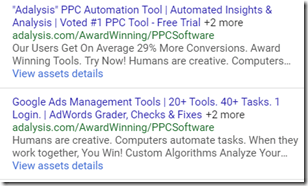Your ad is the only part of your account that a user sees. Perfecting your ad message is crucial to attracting the correct type of traffic that will lead to you hitting your business goals.
The two big questions these days are:
Google recently introduced a 3rd line of ad text. However, there’s a bit caveat here – it might not always show.
When we think of our ads, we start thinking about ad testing; we usually think in two big formulas to start:
Headline 1 waves its hands around and shows that you are relevant to the search term. Headline 2 gives the user a big reason to want to do business with you (a benefit or call to action in most cases). We’re starting the headlines with relevancy and ending with a known message.
The headline 3 can show after the headline 2; but it might not always show. That means if you use the headline 3; you will NOT know how your ad will end as sometimes it will end with the headline 2 and other times it will end with the headline 3. Google does not provide stats to show you data based upon how many headlines were displayed so you can determine your overall ad’s look and feel.
For instance, if we are really focused on a call to action; here’s our two choices:
In the first example; we add the call to action where we think it should show – at the end of the headline. In the second example, we add it as the middle line; which does seem like an odd place to add it since your middle line is an action and your 3rd line might not always be related to that action.
In this case, we can’t pull stats from Google to see how often the 3rd headline shows; but what we can do is look at responsive ads to see how often they are showing the headline 3. In responsive ads, if you click the ‘view asset details’ you can see the combinations that were actually rendered.

Actual Combinations:
Note: there are many more combinations; but in the interest of not overloading screenshots; we’ve just displayed the six most common.
In this example, the 3rd line showed 0.08% of the time. That’s 1 impression of 3 ad lines for every 125 total ad impressions received. Across this entire account; no responsive ad displayed 3 headlines more than 0.1% of the time. That means if our ad uses a call to action as the 3rd line – it will rarely ever be seen.
Since there is so little data for ads with 3 headlines; we didn’t have a good enough data set to try and test out ads with 3 headlines versus ads with 2 headlines. So instead, we decided to test responsive search ads vs. ads with just two headlines to see who was better at controlling messaging – Google or Us.
In one account, we took 10 ad groups and created responsive search ads and a two headline text ad to see who was better at controlling the messaging – the advertiser or Google. While this is a small sample size; you can do this for yourself in your own accounts by just looking at your responsive vs. text ad stats. In this case, the two headline expanded text ads hands down beat the responsive search ads.
As Google’s machine learning is known to have some issues (just look at the optimize ad rotation); this leads us to a few conclusions for this quarter (we’ll want to revisit this data before the holiday season to see if something should change for q4):
1) If you are focused on CTAs, put your CTA in your headline 2. If you want to leverage headline 3, create an ad line that shows a benefit of the CTA and is directly related to the CTA so that your headline 3 supports your headline 2 and doesn’t look like just another headline stuck on the end of your ad.
2) If you are focused on benefits, put your strongest benefit in headline 2, and a supporting benefit in headline 3.
3) If it OK to skip headline 3 right now as it is displayed very infrequently.
4) If you are doing a lot of ad testing feel free to test responsive ads; however, don’t stop your text ad tests in those same ad groups as text ads are still going strong. If you aren’t very good at ad testing (it’s not that hard to learn how to scientifically test your ads), then responsive might be for you as at least someone is testing out some combinations (Google in this instance).
5) Keep an eye on stats Google provides. Right now, we just don’t have enough insights into data for responsive ad combinations or headline 3 stats to do a proper analysis on ad rendered formats to understand what is going to be ‘best’ in the future. We have to work with the stats we can get into; and at the moment, these are the best conclusions anyone can draw based upon the available data.
6) If you want to start testing them yourself, or just mass creating ads using 3rd headlines, take a look at the new Adalysis features that support the 3rd headline and 2nd description lines where you can easily add these new lines (or edit your ads and save new lines) to many ads at once: Easily Upgrade 3rd Headlines & 2nd Descriptions of All Your Google Ads With New Adalysis Features.
Really interesting post that not only highlights what can be shown and when but also suggestions of what to use